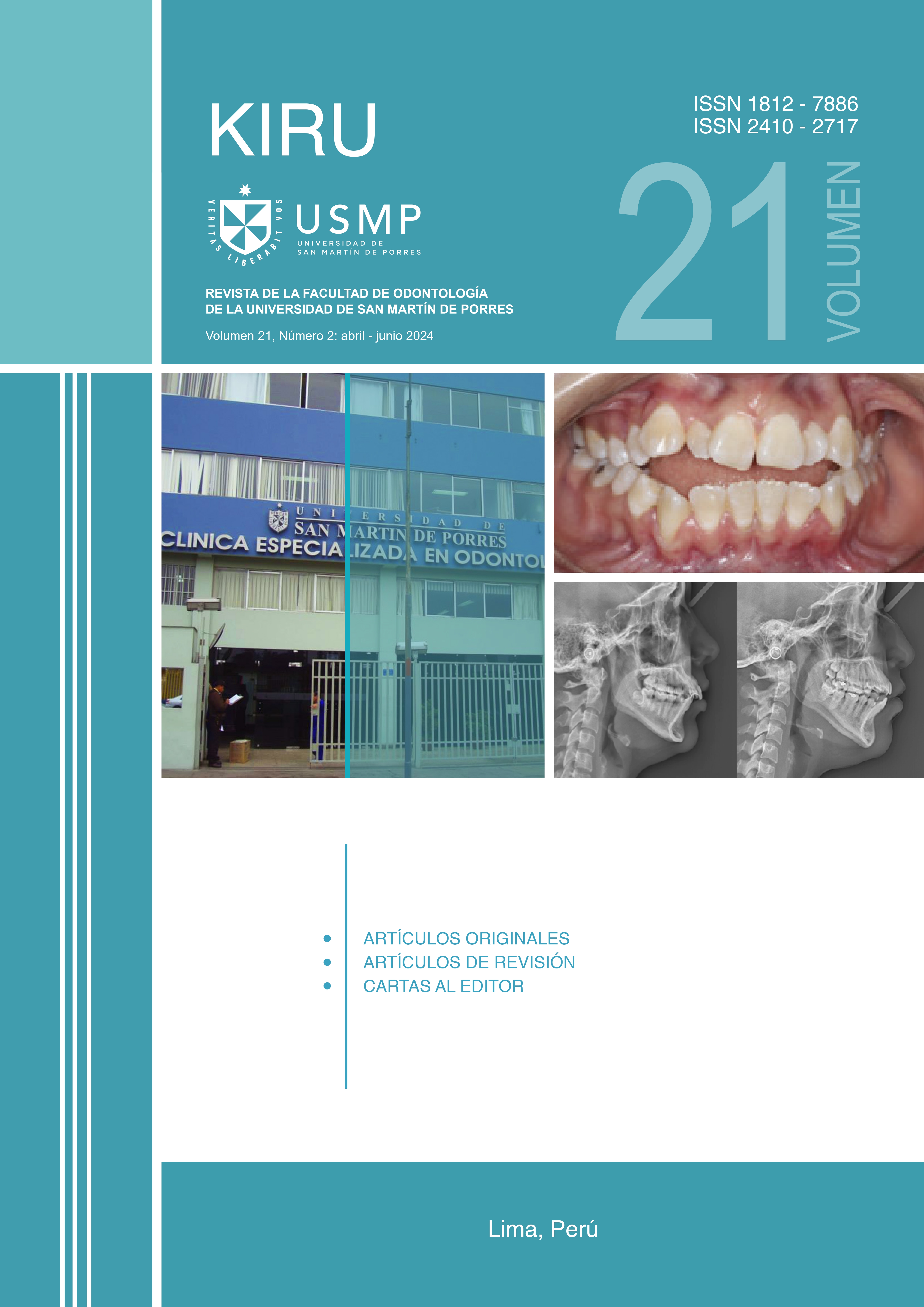Dental and skeletal characteristics of patients with biprotrusion. Narrative review
DOI:
https://doi.org/10.24265/6327fr64Keywords:
Orthodontics; Malocclusion; Dentofacial DeformitiesAbstract
Biprotrusion, defined as the protrusion of the incisors and labial prominence, requires a personalized clinical approach to address both oral functionality and facial aesthetics. Historically, treatment strategies have varied between extraction and non-extraction, highlighting the importance of accurate diagnosis to guide current therapeutic approaches. Therefore, the goal was to conduct a narrative review on the dental and skeletal characteristics of patients with biprotrusion. From a literature search, 352 articles were obtained from January 1, 2018, to February 29, 2024, with 8 selected based on selection criteria and availability. In conclusion, studies reveal discrepancies between Caucasian cephalometric norms and the dental and skeletal characteristics of Afro-Brazilian, Saudi, South African, and Indian populations, emphasizing the need to adapt orthodontic practices to ethnic diversity and to thoroughly review the aggravating characteristics of biprotrusion.
Downloads
References
Rajandram RK, Ponnuthurai L, Mugunam K, Chan YS. Management of Bimaxillary Protrusion. Oral Maxillofac Surg Clin North Am. 2023 Feb;35(1):23–35. doi: 10.1016/j.coms.2022.06.006
Leonardi R, Annunziata A, Licciardello V, Barbato
E. Soft Tissue Changes Following the Extraction of Premolars in Nongrowing Patients With Bimaxillary Protrusion. Angle Orthod. 2010 Jan;80(1):211–6. doi: 10.2319/010709-16.1
Downs W. Analysis of the dentofacial profile. Angle Orthod. 1956;26(4):191–212. doi: 10.1043/0003-32 19(1956)026<0191:AOTDP>2.0.CO;2
Chu YM, Bergeron L, Chen YR. Bimaxillary Protrusion: An Overview of the Surgical-Orthodontic Treatment. Semin Plast Surg. 2009 Feb 9;23(01):032–9. doi: 10.1055/s-0028-1110099
Matos C, Marquezan M, Chaves I, Martins D, Nojima L, Nojima M. Assessment of facial profile changes in Class I biprotrusion adolescent subjects submitted to orthodontic treatment with extractions of four premolars. Dent Press J Orthod. 2012;17(3):132–7. doi: 10.1590/ S2176-94512012000300024
Ogundipe O, Otuyemi O. Surgical and orthodontic treatment methods in patients with bimaxillary protrusion - a systematic review. J West Afr Coll Surg. 2017;7(2):31–46.
Harris DN, Song W, Shetty AC, Levano KS, Cáceres O, Padilla C, et al. Evolutionary genomic dynamics of Peruvians before, during, and after the Inca Empire. Proc Natl Acad Sci. 2018 Jul 10;115(28):E6526–35. doi: 10.1073/pnas.1720798115
Manzur Sandoval N, de los Santos Cazares G, García Cortes JO, Martínez Zumaran A, Flores Arriaga JC. Manejo ortodóntico de paciente con biprotrusión maxilar tratada con extracción de premolares. Rev Mex Ortodon. 2020;8(3):193–200.
Gallardo W. Tratamiento de Biprotrusión Dentoalveolar clase I de angle y clase II esqueletal en adolescente. Rev Univ Guayaquil. 2013;117:4–18. doi: 10.53591/rug. v117i3.861
Pereira CP, Jural LA, Chaves JNT, Silva ARC, Santos MSC, da Silva Coqueiro R, et al. Social and aesthetic impact of dentoalveolar biprotrusion on a white woman. Clin Investig Orthod. 2023 Apr 3;82(2):83–9. doi: 10.1080/27705781.2023.2190946
Rafflenbeul F, Bonomi-Dunoyer H, Siebert T, Bolender Y. First premolar extractions in an adolescent presenting a Class I biprotrusion malocclusion with skeletal Class II: A case report. Int Orthod. 2019 Dec;17(4):817–25. doi: 10.1016/j.ortho.2019.08.017
Oliveira TCP de, Copello F de M, Silva IM de CC, Nojima LI, Nojima M da CG. Dentofacial and skeletal pattern in African descendants from southeastern Brazil: clinical prospective study. Dental Press J Orthod. 2021;26(3):1– 25. doi: 10.1590/2177-6709.26.3.e2119288.oar
Ahmed MA. Cephalometric comparison of Eastman standards among caucasians and saudi population in the Najran region. Bioinformation. 2022;18(12):1173–8. doi: 10.6026/973206300181173
Siddika A, Rahman SA, Alam MK. Cephalometric for Orthognathic Surgery (COGS) Analysis for Saudi Population. Pesqui Bras Odontopediatria Clin Integr. 2021;21(e0090). doi: 10.1590/pboci.2021.151
Osman MI, Sethusa MPS. Hard tissue characteristics of patients with bimaxillary protrusion. South African Dent J. 2023;78(3):130–6. doi: 10.17159/sadj.v78i03.16269
Jha M. Cephalometric evaluation based on Steiner’s analysis on adults of Bihar. J Pharm Bioallied Sci. 2021 Nov;13(6):1360. doi: 10.4103/jpbs.jpbs_172_21
Zhang X, Mei L, Yan X, Wei J, Li YY, Li H, et al. Accuracy of computer-aided prediction in soft tissue changes after orthodontic treatment. Am J Orthod Dentofac Orthop. 2019 Dec;156(6):823–31. doi: 10.1016/j.ajodo.2018.11.021
Siregar RAP, Lubis HF, Yusuf M. Data on alveolar mandibular bone thickness in Class I skeletal patient with bimaxillary protrusion. Data Br. 2021 Dec;39:107423. doi: 10.1016/j.dib.2021.107423
Chanmanee P, Charoemratrote C. Maxillary bone characteristics between thick and thin gingival biotypes with dentoalveolar protrusion. J World Fed Orthod. 2019;8 (3):118–23. doi: https://doi.org/10.1016/j.ejwf.2019.02.002
Downloads
Published
Issue
Section
License
Copyright (c) 2024 Arnaldo Munive Méndez , Isaac Lito Azaña Espinoza

This work is licensed under a Creative Commons Attribution 4.0 International License.
- Los autores/as conservarán sus derechos de autor y garantizarán a la revista el derecho de primera publicación de su obra, el cuál estará simultáneamente sujeto a la Licencia de reconocimiento de Creative Commons que permite a terceros compartir la obra siempre que se indique su autor y su primera publicación esta revista.
- Los autores/as podrán adoptar otros acuerdos de licencia no exclusiva de distribución de la versión de la obra publicada (p. ej.: depositarla en un archivo telemático institucional o publicarla en un volumen monográfico) siempre que se indique la publicación inicial en esta revista.
- Se permite y recomienda a los autores/as difundir su obra a través de Internet (p. ej.: en archivos telemáticos institucionales o en su página web) posterior al proceso de aprobación del manuscrito, lo cual puede producir intercambios interesantes y aumentar las citas de la obra publicada.


